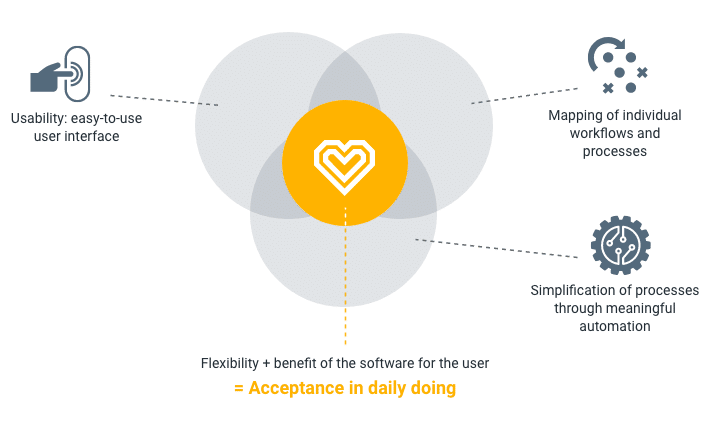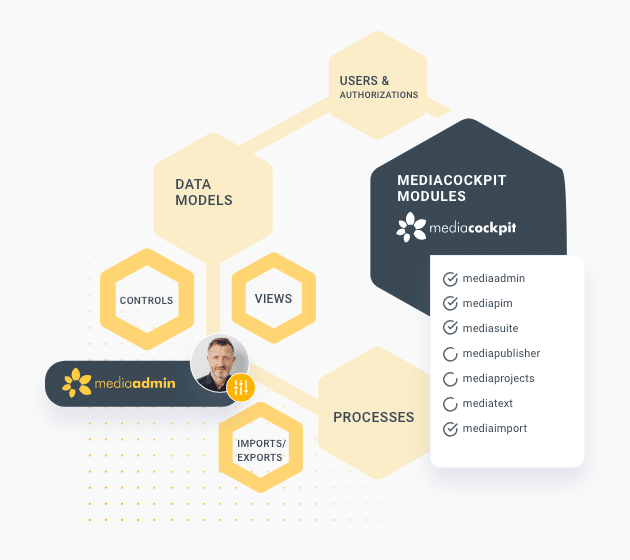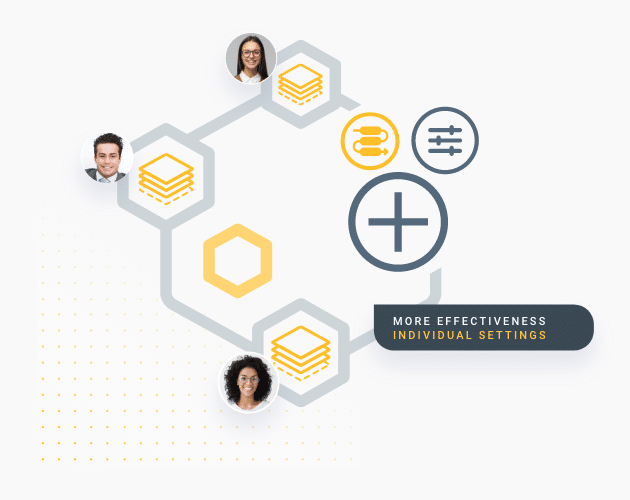Blog
What is the idea behind Configure to Play?

There has been much discussion in the past about the pros and cons of standard solutions. Then there are solutions that require extensive customizing before they can go live in a company. Standard solutions are often seen as very rigid – the range of functions and also the way of working and workflows are generally predefined, which means that users have to adapt to the system. In most cases, users do not even utilize the full functionality of the system or it does not cover all the requirements of the teams. However, the implementation costs are relatively low and the software is robust and easy to maintain. Minor adjustments, such as to the user interface, can be made by the users themselves via configurations.
Systems that have to be extensively adapted to the requirements, data model and work processes before they go live, on the other hand, have the disadvantage that the implementation effort as well as the maintenance and updating of the solution can become very costly due to the large amount of customizing. The advantage, however, is that the solutions are adapted very precisely to the requirements of the business case and adapt to the work processes of the organization.
In favor of the users
Especially in the area of product content management, employees should have access to technologies that optimally support their work. The tasks involved in creating and distributing effective product messages are very extensive – many of the processes involved are repetitive and would be handled more efficiently by software instead of tying up valuable resources resulting in increased cost and a greater chance of errors.
However, due to the complexity of product content processes and the many stakeholders involved, it is also important to find a system that users enjoy working with. The ROI of a software solution always stands or falls with user acceptance, and this is especially true for basic technologies such as PIM and DAM.

For this reason, out-of-the-box solutions are, in principle, less well suited for this task. Teams must be able to map their individual workflows and find their ways of working in the solution. At the same time, data processes in the PIM and DAM disciplines are company-specific and should remain adaptable for future challenges in any case.
Customizing becomes Configure to Play
This does not mean that every system implementation has to become a mammoth project. Modern programming techniques allow adjustments which would previously have fallen under customizing to be offered as configuration options, merging the advantages of both approaches. Ultimately, technology should be an enabler for companies that strive for digital success and want to be prepared for future business challenges. To achieve this, it must be one aspect above all: simple and intuitive to use.
That’s why we, at Bertsch Innovation, have equipped our product content management solution mediacockpit with the mediaadmin module, which offers users the option of creating specific rules and customizing views very easily and without any programming knowledge at all, using Configure to Play.
Configuration options in mediaadmin
Users can easily assemble even the most complex search queries and workflows in mediacockpit by configuring modules and data models. As a result, employees save valuable time that they can use for more important tasks. At the same time, the ability to digitally map individual work processes independently increases employee satisfaction and acceptance of the solution. The onboarding of new employees is also significantly simplified.

What are the benefits of Configure to Play?
Configure to Play helps organizations build a comprehensive understanding of data processes and data quality. Users identify themselves and their work more easily and intensively with the solution they are using, and they work more proactively to optimize data processes independently. As a result, Configure to Play can even help enforce data governance in the organization and make it an integral part of work processes.
At the same time, Configure to Play offers a high degree of flexibility for future adaptations – and this does not only apply to the user interface of individual employees. A highly integrative approach enables companies to quickly and easily establish new processes, incorporate new plug-ins and creative tools, and create the basis for new, innovative business models. Product content management must grow with the company and offer employees the best possible support – no matter what the future holds.

High adaptability is all the more important when data models, requirements and work processes in the company are complex. In such environments, there are many different users involved in the product content processes, and each individual has a unique perspective. With Configure to Play, each of these perspectives can be mapped and the complexity can be broken down to the common denominator: the creation of optimal product content.
That’s why we developed mediacockpit in a way that allows users to autonomously decide how they want to work with the system – and then easily implement it themselves.
If you want to learn more on how to configure your product content management system, sign up for a free demo now!
Accomplir plus ensemble
Nous croyons en la valeur de la collaboration et de l’échange. Cela s’applique aussi bien à nos projets clients, desquels nous tirons de nombreuses informations précieuses pour le développement de nos produits, et à notre réseau de partenaires en pleine expansion, avec lequel nous soutenons nos clients dans leur numérisation.


